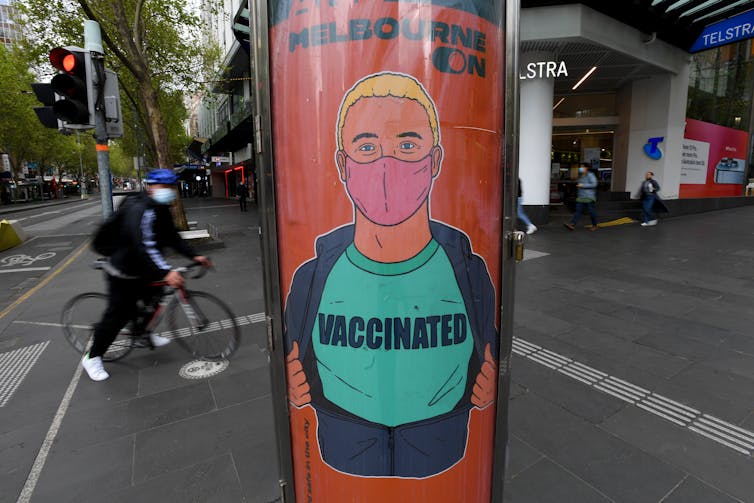Racing to hit vaccination targets and lift the restrictions making Melbourne the world’s most locked-down city, the Victorian government has mandated COVID vaccinations for an estimated 1.25 million of the state’s 3.5 million workers.
The order applies to all “authorised providers” and “authorised workers” whose work requires contact with others. By October 15 they must show proof they have received or booked their first vaccination, or have a medical exemption from a authorised practitioner. Anyone without an exemption must be fully vaccinated by November 26.
Separate deadlines apply for those subject to Victoria’s existing mandatory vaccination directions covering health care, construction workers and teachers.
Who are the ‘authorised’ providers and workers?
An authorised provider or worker is any business or person exempt from the orders to shut or work at home during lockdown.
The “authorised providers” list includes supermarkets, restaurants and cafes providing takeaway services, bottle shops, banks, post offices, news agencies, petrol stations, child care services, schools and mobile pet-grooming services.
The “authorised workers” list covers more than 70 categories. It includes health practitioners, emergency workers, essential services workers, those who work in courts or the administration of justice, manufacturing, public transport, professional athletes, zoo workers, faith leaders, actors and parliamentarians.
In short, if your work can’t be done from home, your job is most likely on the list.
Are there any exemptions?
There is an exemption for those unable to be vaccinated on medical grounds, as determined by the Australian Technical Advisory Group on Immunisation. The list of accepted medical reasons is short. Any exemption must be certified by an authorised medical practitioner.
What makes this legal?
The state government has the power to make public health directions including mandating vaccines under Victoria’s Public Health and Wellbeing Act and associated state-of-emergency powers. It is the same mechanism by which vaccinations for sectors such as construction have been mandated.
Prior to the COVID pandemic, similar provisions have enabled the Department of Health to direct hospitals and health providers to require workers to be vaccinated against diseases such as influenza and hepatitis B. This was achieved through amendments to Victoria’s Health Services Act and Ambulance Services Act.

Doesn’t this conflict with the Fair Work Act?
No. The Fair Work Ombudsman has previously issued guidance on the conditions that make it lawful and reasonable under the Fair Work Act for an employer to require that employees be vaccinated. That guidance includes “tiers” of work to help assess if vaccination was justifiable. But these aren’t relevant if a direct law – in this case a public health direction – mandates vaccination.
Is there any legal recourse?
There is already one legal challenge before Victoria’s Supreme Court. This has been lodged by couple Belinda and Jack Cetnar. Their core argument is the mandate is discriminatory and contravenes human rights.
One difference between this challenge and those being made in the NSW Supreme Court against the NSW government’s vaccine mandates is that Victoria has a Charter of Human Rights and Responsibilities.
At the hearing setting the trial date for the Cetnars’ challenge, Justice Melinda Richards noted the Cetnars had grounds to argue their a case under the Charter but queried other arguments they presented in their written documentation. These included the mandate contravening the Commonwealth Biosecurity Act and the Nuremberg Code.
So what about discrimination and human rights?
Vaccination status is not a prohibited ground under discrimination law, so the mandate cannot be challenged as unlawful discrimination on this basis. Adverse treatment on the basis of health or disability may amount to unlawful discrimination in other circumstances, but the new rules allow for this.
Human rights law allows for limitations on human rights where necessary to protect public health and the fundamental right – to life. However, such restrictions must be necessary and proportionate to the risk and balanced against individual rights.
This principle is reflected in Victoria’s Charter of Human Rights and Responsibilities, and in the position of bodies such as the World Health Organization.
In December 2020, at press conference, WHO’s immunisation director Kate O’Brien said the organisation didn’t favour vaccine mandates.
However, a WHO policy brief published in April notes vaccine mandates “can be ethically justified, as they are crucial to protecting the health and well-being of the public”. This comes with important caveats:
While interfering with individual liberty does not in itself make a policy intervention unjustified, such policies raise a number of ethical considerations and concerns and should be justified by advancing another valuable social goal, like protecting public health.
Ultimately it may be necessary for the courts to determine whether the new rules strike an appropriate balance. However, it seems unlikely any court will overturn this mandate, given vaccination is effective, the mandate is temporary, applies only to onsite work, provides medical exemptions, will alleviate pressure on the health system and help ease existing restrictions (which also infringe on individual liberty).
Who is responsible for enforcing these rules?
Workers covered by the mandate will be required when working to carry an authorised worker permit confirming they have been vaccinated. Businesses will be responsible for issuing these permits, and for ensure all employees onsite have a permit.
If an authorised officer attends a workplace and finds workers without a valid permit, both employers and employees can be fined.
The penalties are the same as other breaches of restrictions or directions. On-the-spot fines of up to $1,817 can be issued to individuals and up to $10,904 for businesses for not having a permit.
A court can impose a fine of up to $21,808 on individuals and $109,044 on employer for issuing worker permit to an employee not meeting the permit requirements.
This article was written by:








